Kirant and Kirantis
About Us
About Us
Kirant
The present Kirant area in Nepal is also known as area of ‘Sapta Koshi’. East of Kathmandu, from Makwanpur Gandhi, including area East of Sunkosi upto Kikhu Khola, is known as Var Kirat or near Kirant. It is the area of Sunwars and some non Kirant tribes like Tamang, Chepang and Majhi. The area between Dudhkosi up to Arun river is Majh Kirat or middle kirant, is the area of Rais. The high mountains are inhabited by the Sherpas and Terai is occupied by the Tharus. East of Arun river, till Mechi river, live the Limbus. This area is called ‘Par Kirant’ or far Kirat. On the lower Mechi river, banks live meche. Yakhas too form part of Rais and are called Yakha Rai or Dewaan Rai.
Kirantis
Kirantis came to Nepal from the east beyond the borders of present day Nepal. Around 1500 BC they began to establish and expand a kingdom starting from Kandhar in Present Afghanistan to far East Kandhar, which was known as Gandhar in ancient times. By Ramayan and Mahabharat era they were well established in Indian subcontinent with their capital at Pragiyotishpur in Northern upper Assam. However, it is believed that they reached the Kathmandu Valley only by 600-700 BC. For over a millennium, the held absolute sway over the Kathmandu Valley and even installed their own ruling dynasty. Rais and Limbus are also found in West Sikkim and Darjeeling Hills. Till 1642 AD all area East of Arun River upto Teesta River, including Sikkim and up to Jalpaiguri was known as Limbuwan and all the above mentioned tribes who resided in it were collectively known as Kirantis, derived from tow words Kira-Lion and Ti People, literally meaning Lion People. By 1774 the Shah rulers of Kathmandu conquered area East of Kathmandu Valley but, due to the difficulty of administration they used influential persons amongst local tribes to collect tax and carry out land management . To distinguish them they were conferred the ‘Lal Mohar’ the seal of authority. Thus Limbu tax collectors were know as ‘Subba’, Khambu as ‘Rai/ Jim or Jimidar’, Sunwar as ‘Mukhia’ and Yakha as ‘Dewan’. Over a period these titles have become clans in these tribes. The Regiment’s manpower is mainly from Rais, Limbus and Tamangs with a small sprinkling of Sunwars, Sherapas, and others.
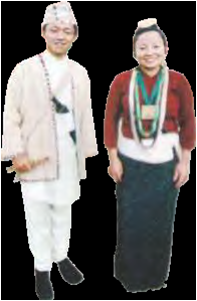
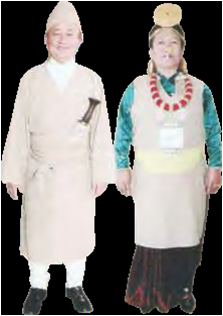

Language
In Nepal, each ethnic group has a distinct language and dialect. However, the common language understood by all is Kas Kura; like the one spoken in the Regiment. Most of the Kirant, Tribals have their own language/dialect.
Religion
All Kirantis follow a mix of Animism, Shamanism and ancestral worship. People living in high hills of north also follow certain Buddhist ceremonies and use Lamas for conduct of religion rituals. People in South are gradually being influenced by Hinduism and employ Brahmin for certain religious ceremonies. Limbus use Phedangma (Tribal Priest) for all the religious ceremonies within the house. Outside the house Yeba, Yebani (female) of Samba are used. Rais use Jhakri, Bijwa and Dhami as priest. Limbus worship Theba Samba (Grandfather God) and Yuma Samba (Grandmother Goddess) . In the hills Yosumang (Undhavali) and Tosumang (Umbhavali) are observed. Undhavali is observed at the time of harvesting and Umbhavali is observed. Undhavali is observed at the time of harvesting and Umbhavali is observed at the time of sowing. Although the Tamangs follow Lamaism, all Hindu festivals are also celebrated by them.
Rituals
Rais have an important ritual called ‘Chandi’, celebrated on Baisak Purnima. On this day they visit ‘Chandi Than’ (Chandi Temple) and celebrate this festival with great enthusiasm, singing and enacting ‘Chandi Dance’. Their popular musical instrument is ‘Binayo’ made from a piece of thin bamboo(malingo).
Limbus are also good in singing and dancing. ‘Dhann Nach’ is a popular dance amongst the Limbus and is performed after harvesting the paddy. Tamangs are lovers of entertainment. Their popular musical instrument is ‘Damphu’ and their dance is called ‘Tamang Selo’ which requires the rhythmic beat of a ‘Damphu’. All the life cycle rituals like ‘Birth’, ‘Naming’, ‘Wedding’, Child Birth and Death rites are performed by these tribes as per their custom. Some Rais bury their dead while others cremate them. Limbus generally bury their dead. Tamang’s last rite is performed on hill top rather than on the river bank. Most Tamangs cremate their deads but some bury them, too.

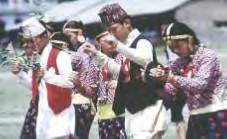
Dhaan Nach Chandi Nach
Festivals
Gorkha are very devout people and celebrate almost all the Hindu festivals like Dushera, Diwali (called Teohar in Nepali), Holi, Raksha Bandhan, Sansari Mai Puja, Mahashivratri, Buddh Yayanti, Gai Jatra, Saraswati Puja, Krishna Janamashami, Lohsar and Teej. In addition, they worship the deities of their respective tribe. Most of the Nepalese are followers of Hinduism, followed by Buddhism, Christianity and others. Festiv als in Nepal are many and celebrated throughout the year as religious a nd cultural festivals. Dashera or ‘Dassain’ is the main Hindu festival of the Gorkhas. It commemorates the heroic battle in which Goddess Durga conquered ‘Mahishasura’, a demon with the head of a bison. The ten-day festival signifies victory of ‘Good over the evil’. On the eighth day (Ashtami) , at ‘Kalratri’ (midnight), a black goat is sacrificed.
The climax comes with the ritual of Maar on the ninth day (Navmi) when ‘Mha Balidan’ (Maar) is performed where a male is sacrificed. After a clean cut, loud cheers greet the person who does the ‘Maar’ and a white Pheta (turban) , as an honour, is then tied on his head by the Commanding Officer and a cash reward is also given. Sacrifices of smaller male animals are also made at this time. The day is celebrated with gaiety. On the tenth and final day (Vijay Dashmi) the Pandit and Commanding Officer apply the holy mark (Tika) on the foreheads of Officers, JCOs and OR.
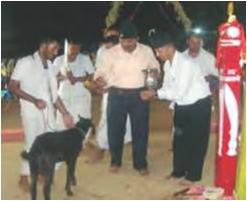

The Khukri
“ Khukri” is a heavy , crescent shaped versatile knife that is used both as a tool and a weapon. It is the legendary Close Quarter Battle weapon of the Gorkha fighter, History is replete with examples wherein the “Nango Khukris” in raised hand of the Gorkha soldiers have caused the enemy to flee in terror.
Shape & Dimension. There is no specific set of shape and dimension but the standard length of service and general use khukri is about 30 to 35cms. It is curved slightly (approximately at an angle of 20 degrees) and the width is about five to ten cms tapering towards the edge from the broad upper margin. A kothimora khukari (decorative khukari for presentation) may be of any reasonable size though the standard size is preferred. Ceremonial and sacrificial khukris are most impressive.
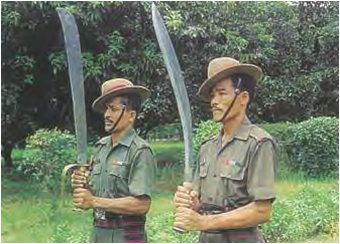

Marr Khukri 11GRRC Lucknow (Top to bottom) Sheath, Khukri, Chakmak and Karda
|


Presentation Khukri Marr Khukri
|